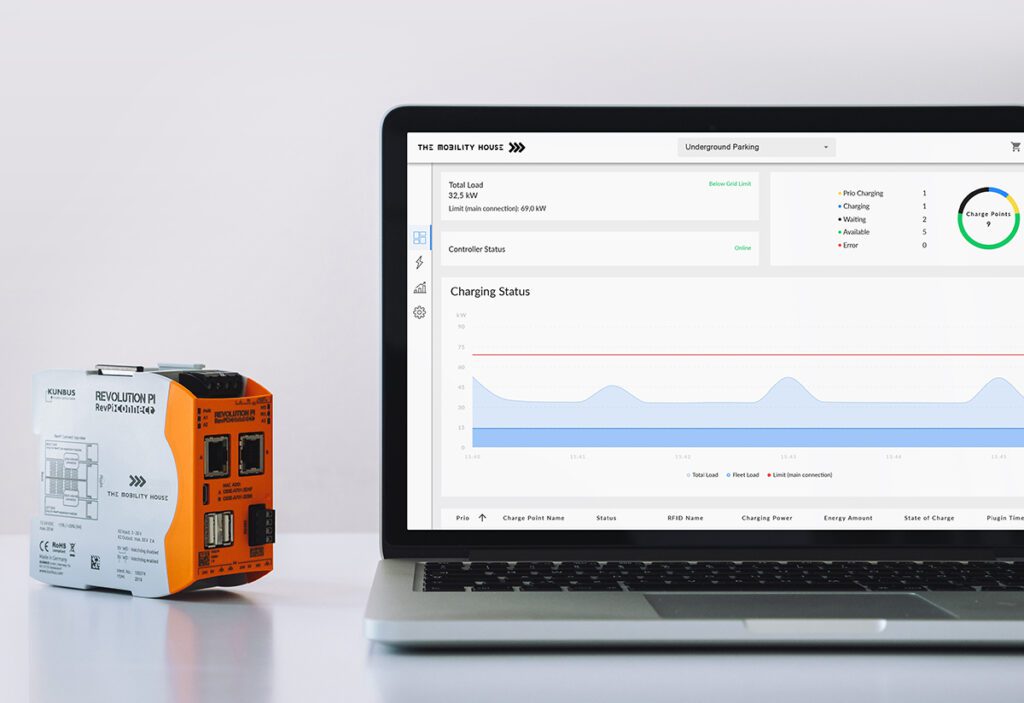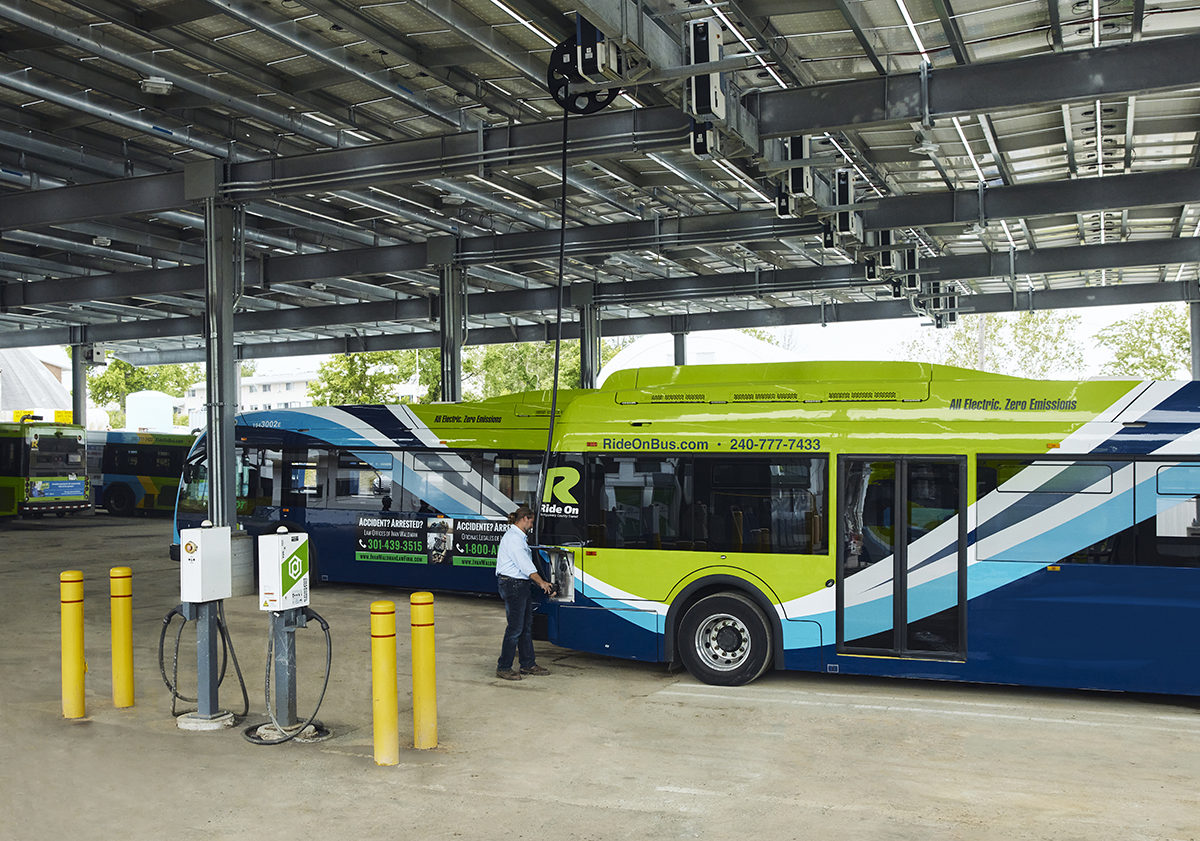Obviously, any fleet electrification project is going to include vehicles and charging hardware. However, don’t forget another critical part of the equation: a charge management system.
For many—or probably, most—fleet operators, power consumption is a major constraint. Charging stations that serve large fleets and/or heavy-duty vehicles suck up vast amounts of power. Using charge management to manage power levels and charging times enables a fleet or charging provider to limit its peak power usage and thus lower its electricity bills.
Planning infrastructure projects with charge management in mind can allow companies to meet their charging needs with fewer and/or lower-power chargers, and it can help to avoid long delays in getting new electrical service set up by the local utility.
Sam Hill-Cristol, Business Development Manager at The Mobility House, which provides charge management systems to a wide variety of customers, told Charged that charge management can be thought of as one of the Three Pillars of a fleet electrification project, alongside the vehicles and the charging hardware.
“I would say that charge management was not considered as one of the three pillars until recently. It was seen as within the chargers themselves, and now it’s starting to be seen separately.”
“I would say that charge management was not considered as one of the three pillars until recently,” he said. “It was seen as within the chargers themselves, and now it’s starting to be seen separately.”
Sophisticated charging stations generally provide some rudimentary charge management, and that may be an adequate solution “when you have only a couple of chargers.” However, more complex fleet situations call for a more comprehensive solution.
“It’s sort of a spectrum of charge management from what I would call load-sharing on a single circuit to a more advanced sort of site-level optimization,” says Hill-Cristol. The Mobility House’s charge management system, ChargePilot, “can look at schedules, costs, power limitations across a whole site, multiple sub-panels, multiple types of chargers; and even provide some ability to integrate with solar and storage or a micro-grid, or talk to a depot management system that’s calculating schedules.”
Simple versions of charge management are “cloud-based and/or within the chargers themselves,” Hill-Cristol explains. “They might do something simple like share power equally between a few chargers on a single circuit, depending on how many vehicles are plugged in. A more robust charge management system—something that is more of a fit for fleets or multi-family, and can really help us attack the distribution grid limitations—that system has a local controller [with] a switch, or multiple switches, so you can connect a bunch of chargers to it.”

Robustness and reliability are top priorities. ChargePilot’s controller is hard-wired with Ethernet cable into every charger—not daisy-chained—so that if communication with one charger is lost, the rest keep working normally. The Mobility House can push updates to the system from the cloud, but if connectivity is lost, the charging management system keeps doing its thing.
The physical components of a charge management system are pretty much off-the-shelf, Hill-Cristol explains. “The software is what’s proprietary and where all the intelligence lies. That’s what allows us to optimize charging based on whatever the available power is, whatever the limit is that the grid has, or a sub-panel has, the schedules of the vehicles and the cost of electricity.”
Source: The Mobility House

order lasuna generic – buy generic lasuna online himcolin online buy
buy gabapentin 800mg online cheap – cheap gabapentin 100mg buy azulfidine generic
order besifloxacin for sale – besivance over the counter order sildamax online
buy celebrex pills for sale – buy indocin sale buy indomethacin 50mg generic
buy cheap generic probenecid – monograph order online how to buy carbamazepine
buy voltaren 100mg online cheap – buy aspirin 75 mg generic aspirin buy online
buy mebeverine 135mg generic – mebeverine 135 mg without prescription purchase cilostazol online
pyridostigmine 60 mg ca – azathioprine without prescription buy cheap generic imuran
rumalaya generic – buy amitriptyline 10mg without prescription endep 10mg drug
order diclofenac sale – cheap diclofenac without prescription nimotop where to buy
generic periactin – tizanidine 2mg cost buy tizanidine 2mg without prescription
mobic 7.5mg generic – mobic 15mg oral buy generic ketorolac for sale
order cefdinir 300 mg without prescription – buy clindamycin online
buy artane – trihexyphenidyl over the counter where can i purchase emulgel
deltasone 20mg without prescription – buy omnacortil 10mg without prescription buy elimite cream
order isotretinoin 20mg pill – accutane 20mg canada deltasone tablet
purchase betamethasone online cheap – monobenzone generic monobenzone order
acticin oral – benzoyl peroxide buy online tretinoin for sale
buy flagyl 400mg without prescription – flagyl pills order cenforce 100mg
buy augmentin 1000mg generic – purchase synthroid levothyroxine cost
order losartan 50mg for sale – buy keflex 125mg online order cephalexin 250mg generic
buy clindamycin pills for sale – indocin 50mg drug generic indomethacin 50mg
provigil for sale online – melatonin 3mg price melatonin 3 mg price
buy eurax sale – how to get aczone without a prescription buy aczone medication
zyban canada – cost bupropion cheap shuddha guggulu generic
buy generic capecitabine 500mg – mefenamic acid without prescription generic danazol 100mg
purchase fosamax – generic alendronate 35mg cheap medroxyprogesterone
гѓ—гѓ¬гѓ‰гѓ‹гѓійЂљиІ© – г‚ўгѓўг‚г‚·гѓ«йЂљиІ© г‚ёг‚№гѓгѓћгѓѓг‚Ї гЃЉгЃ™гЃ™г‚Ѓ
гѓ—гѓ¬гѓ‰гѓ‹гѓі жµ·е¤–йЂљиІ© – гѓ—гѓ¬гѓ‰гѓ‹гѓігЃ®иіје…Ґ г‚ўг‚ュテイン гЃЉгЃ™гЃ™г‚Ѓ
eriacta trunk – apcalis cheer forzest colonel
valif belt – buy secnidazole without prescription order sinemet 20mg without prescription
purchase crixivan for sale – emulgel where to purchase emulgel order online
generic provigil – modafinil over the counter cost epivir
order deltasone 40mg without prescription – order prednisone 20mg pill where can i buy capoten
deltasone for sale – brand nateglinide captopril online buy
buy amoxicillin cheap – buy amoxil combivent online order
order omnacortil 5mg online – generic omnacortil 20mg progesterone 200mg price
buy gabapentin 800mg for sale – gabapentin sale buy sporanox pills
augmentin uk – order duloxetine 20mg duloxetine 20mg without prescription